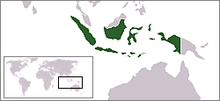Environment of Indonesia

The environment of Indonesia consists of 17,508 islands scattered over both sides of the equator.[1][2] Indonesia's size, tropical climate, and archipelagic geography, support the world's second highest level of biodiversity after Brazil.[3]
Issues
Indonesia's high population and rapid industrialisation present serious environmental issues, which are often given a lower priority due to high poverty levels and weak, under-resourced governance.[4] Issues include large-scale deforestation (much of it illegal) and related wildfires causing heavy smog over parts of western Indonesia, Malaysia and Singapore; over-exploitation of marine resources; and environmental problems associated with rapid urbanisation and economic development, including air pollution, traffic congestion, garbage management, and reliable water and waste water services.[4] Deforestation and the destruction of peatlands make Indonesia the world's third largest emitter of greenhouse gases.[5] Habitat destruction threatens the survival of indigenous and endemic species, including 140 species of mammals identified by the World Conservation Union (IUCN) as threatened, and 15 identified as critically endangered, including the Sumatran Orangutan.[6]
Environmental policy and law
Treaties and international agreements
Indonesia is a signatory to a number of treaties and international agreements:
- Party to - Biodiversity, Climate Change, Desertification, Endangered Species, Hazardous Wastes, Law of the Sea, Nuclear Test Ban, Ozone Layer Protection, Ship Pollution, Tropical Timber 83, Tropical Timber 94, Wetlands
- Signed, and ratified - Climate Change-Kyoto Protocol
- Signed, but not ratified - Marine Life Conservation
Domestic environmental laws
See also
- Agricultural Involution: The Processes of Ecological Change in Indonesia (book)
- Biodiversity of Borneo
- Environmental issues in Indonesia
- Greenlifestyle
- Mangroves of the Straits of Malacca
- Fauna of Indonesia
- Flora of Indonesia
- Climate of Indonesia
- Geography of Indonesia
- Protected areas of Indonesia
References
- ^ "Hanya ada 13.466 Pulau di Indonesia". National Geographic Indonesia (in Indonesian). 8 February 2012.
- ^ "The Naming Procedures of Indonesia's Islands", Tenth United Nations Conference on the Standardization of Geographical Names, New York, 31 July – 9 August 2012, United Nations Economic and Social Council
- ^ Brown, Lester R. (1997). State of the World 1997: A Worldwatch Institute Report on Progress Toward a Sustainable Society (14th edition). New York: W. W. Norton & Company. p. 7. ISBN 0-393-04008-9.
- ^ a b Jason R. Miller (30 January 1997). "Deforestation in Indonesia and the Orangutan Population". TED Case Studies. Retrieved 14 August 2007.
{{cite journal}}: Cite journal requires|journal=(help) - ^ Higgins, Andrew (19 November 2009). "A climate threat, rising from the soil". The Washington Post. Retrieved 11 December 2009.
- ^ Massicot, Paul. "Animal Info – Indonesia". Animal Info – Information on Endangered Mammals. Retrieved 14 August 2007.
